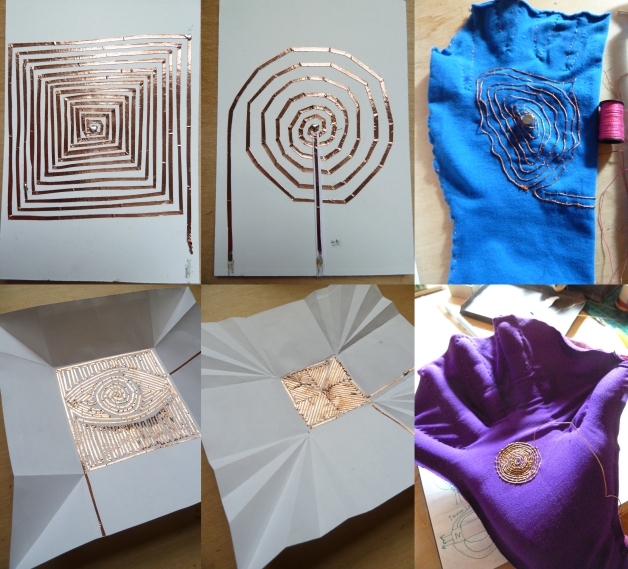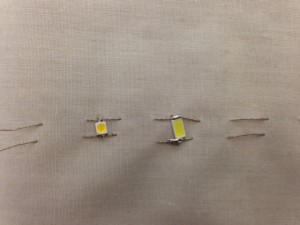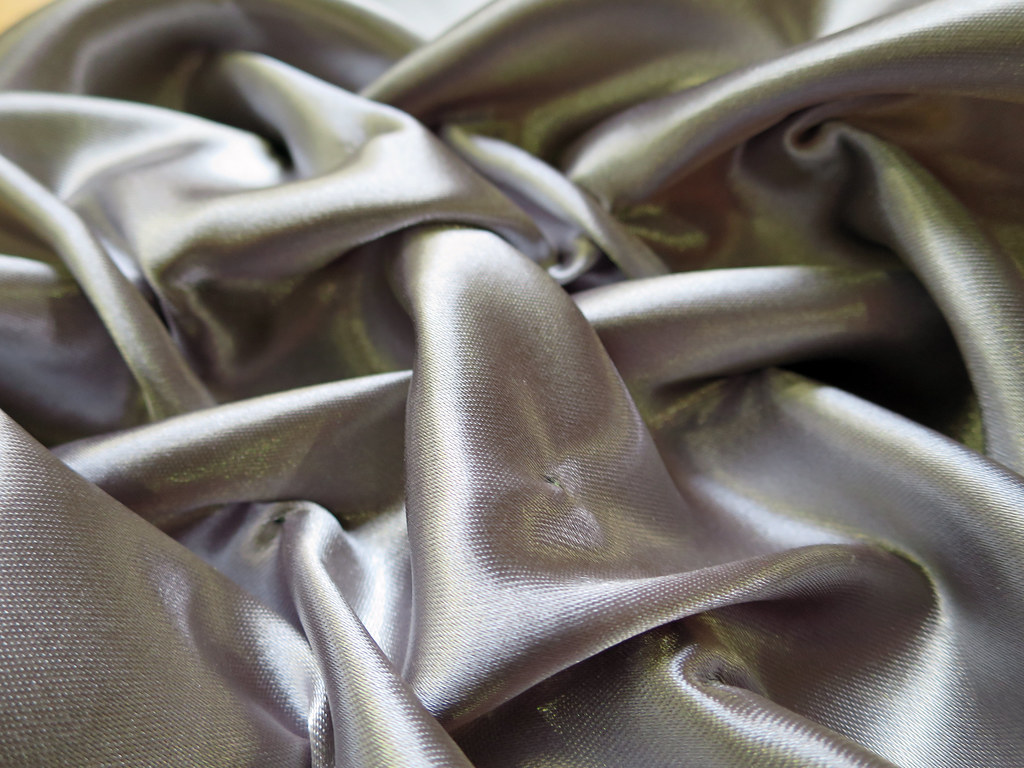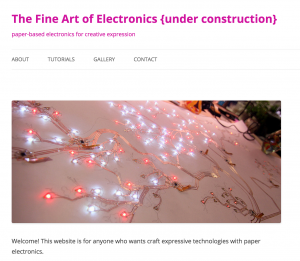Building Heat Controlling Circuit workshop from eTextile Summercamp, 2013
+ Information about circuits, power, and materials.
Category Archives: Resources
SMD (Surface Mount) LEDs
Here is a link to a seller on eBay. I like the 1210/3528 SMD size (smaller, thicker ones) and the other ones I demoed with are 5630/5730 (the larger, thinner ones).
MOTION: Flexinol
Materials:
Paper and fabric of various weights
Resources:
How-To: Work with Shape-Memory Alloy
(FYI we will be working with .006 flexinol)
SMA meets Smocking
More Physical Than Computing, Research on SMAs
Continue reading
HEAT + INKS: Thermochromics

Thermochromic Tutu, Lyndsay Caulder
Resources:
Building a heat controlling circuit
Painted Displays
4-channel color changing textile
SOUND: Paper + Fabric Speakers

Speakers, Becca Rose
Tools you need:
Sound recording module, old (working) pair of headphones, or a sound greeting card
Resources:
These are only a few of the vast resources – email me if you find more to include!
Sound amplifying circuits
Sound fabric
Week 11: Output + Actuators
For the next two classes, we are venturing into the realm of OUTPUT and ACTUATORS!
Per our decision last class, we are taking a new approach rather than the traditional “I talk, You make.” Instead, I will introduce the heat-controlling circuit we will be working with then you will break out into interest groups: sound, heat + inks, and motion. You can dive deep into one or get a smattering of all three.
Here’s what you need to do before next class:
1) Look into the resources for the output you would like to learn:
+ SOUND
+ HEAT+INKS
+ MOTION
2) Bring the following materials to class in addition to your regular materials:
+ SOUND: Recording module from Radioshack, an old (working) pair of headphones, or a sound greeting card.
+ INKS: Paint brushes
Optional: Small trays for mixing/storing paint, different types of binders, inks, and paint to mix with the thermochromic
+ ALL: Paper and fabric of various weights
Below is your design brief for the next two classes. You will submit a homework assignment due 11/24 based on this brief:
Design a tool that creates, saves, deletes, or alters memories. Imagine a possible or potential future in which your tool exists and who it’s users are.
Memories define who we are. They can be impressions, bytes of data, feelings, objects, events, synapse firings. They can be individual or collective. Some of us have perfect memories, while others suffer from crippling degenerative diseases. They can be multi sensorial – based in touch, sound, motion, sight, and smell. They can grow stronger, weaker, or distorted with time.
For thousands of years, we have recorded our memories in various craft forms, using textiles, fibers, paper, wood, clay, etc as our dominant materials. With the rise of digital technologies, we now embed them in pixels and polymers, preserving them by the terabyte. For the most part, our memories are devoid of materiality. This will only increase as time goes on…
WEEK 7 ATtiny Code (UPDATED)
HOW TO:
Download the zip file. Place in it your Arduino folder (probably in your Documents folder) and unzip it:
GETTING STARTED:
Here is the VERY HELPFUL getting started tutorial for working with the ATtiny.
INCLUDED:
Code and schematics for each
Capacitive Sensing
1) CapSense_Arduino_with_LED
Use this with Arduino
2) CapSense_ATTiny
Use this with the ATtiny
3) CapSense_ATTiny_SoftwareSerial
Use this to read sensor values from ATtiny. Here is a helpful tutorial.
Human Circuit
1) HumanCircuit_with_Arduino_LED
Use this with Arduino. Can adapt to ATtiny
2) Touch_ATtiny_Mellis
Use this with ATtiny. Has been finicky for some. Here is the documentation.
New resource for paper electronic construction!



